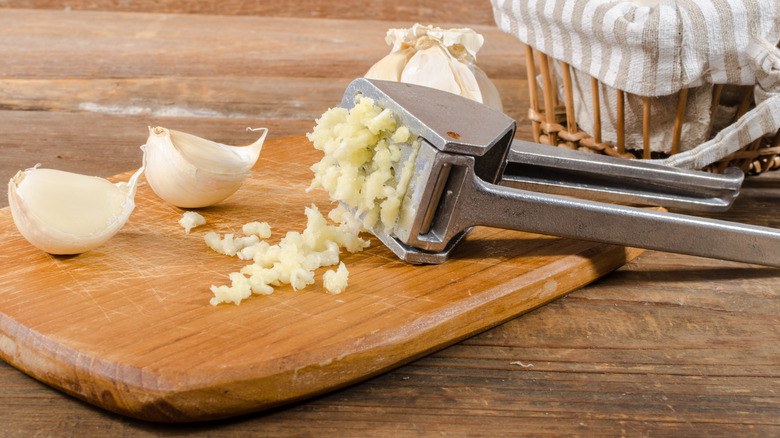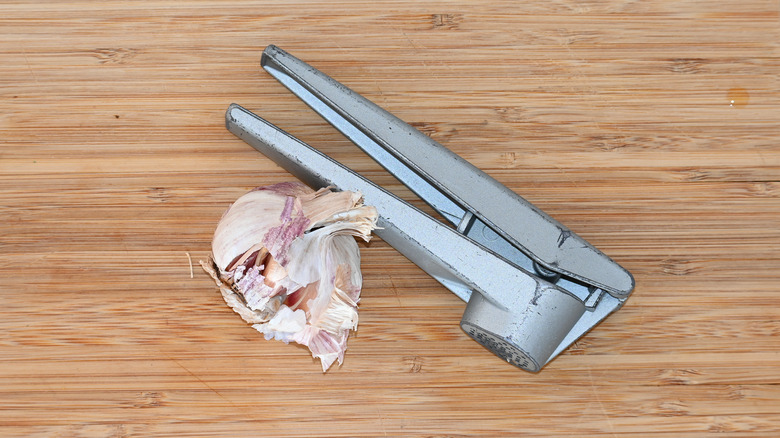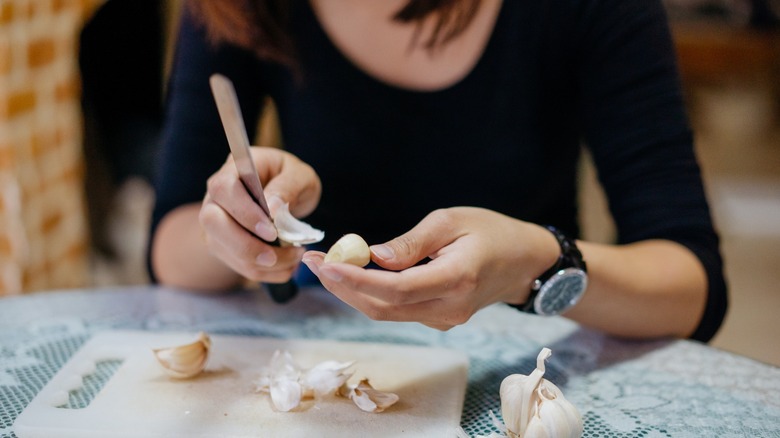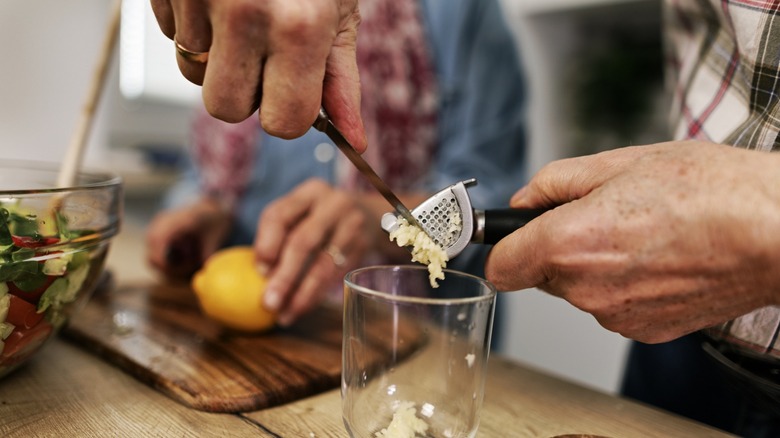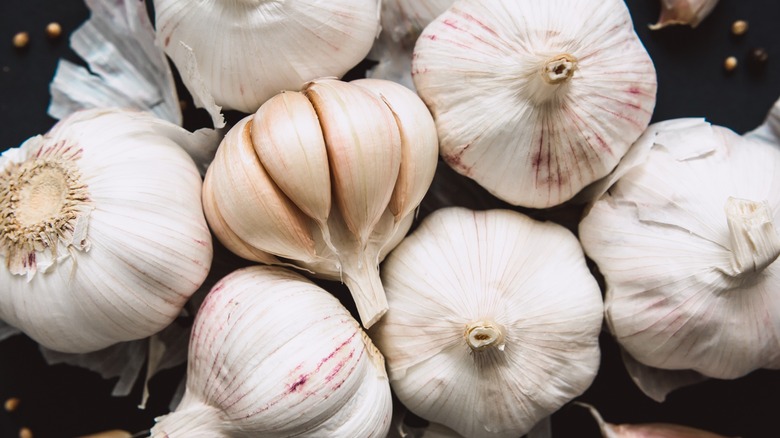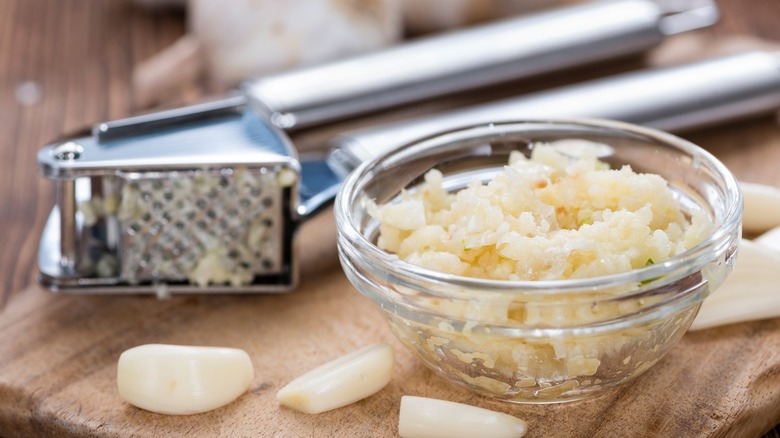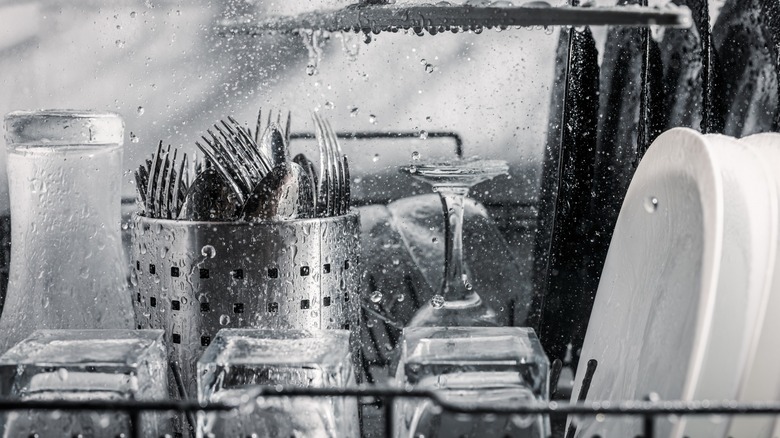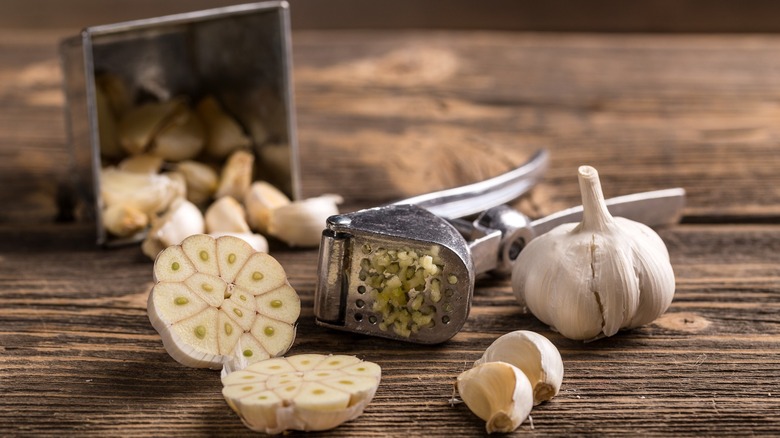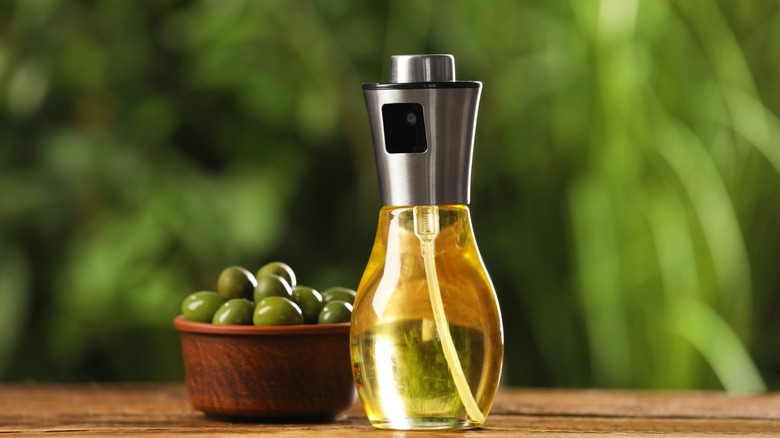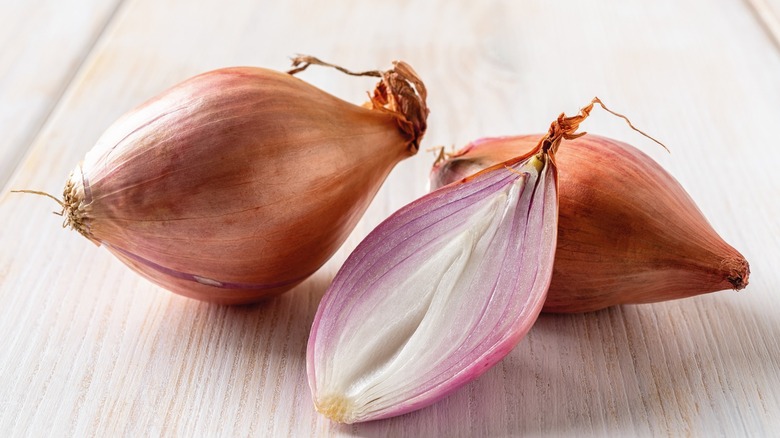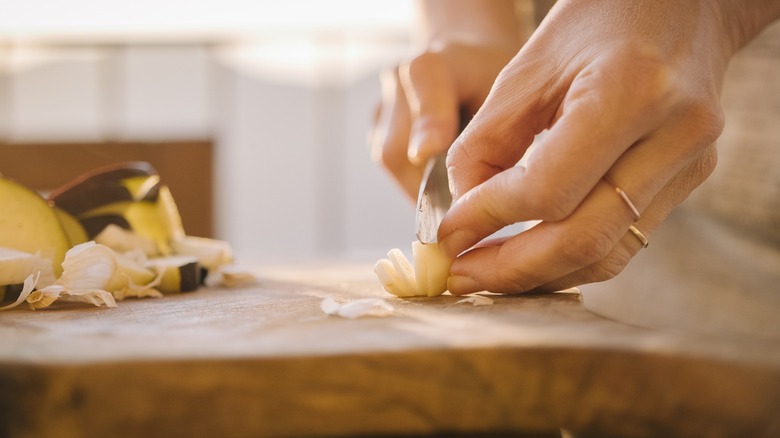10 Mistakes Everyone Makes When Using A Garlic Press
Ah, the humble garlic press! A quick, easy way to crush garlic for all your favorite dishes, from garlic bread to garlicky chicken breasts, no knife or garlic-scented hands in sight. Right? There's no denying that a garlic press makes light work of crushing garlic and is a handy kitchen gadget to have in your home.
However, do you really know how to use your garlic press? Though you might think it seems pretty simple, it turns out that you may not be using your garlic press the right way — and you're not alone. There are a ton of mistakes everyone makes when using a garlic press, from peeling the cloves to throwing their garlic press in the dishwasher.
We'll dive into 10 mistakes everyone makes when using a garlic press and explain where you're going wrong. Which of these mistakes have you made? We won't judge — in all honesty, we've probably made them too!
1. Buying the cheapest option
This first mistake many of us make when it comes to garlic presses happens before you even get your hands on one. Buying the cheapest garlic press out there will give you serious regret. It's a tool you'll use almost daily if you love cooking, so don't be afraid to drop some serious cash on it.
The key when shopping for a garlic press is to look for one that's sturdy and made from durable materials. Also, check that it's easy to clean — some garlic presses have removable sections, which makes cleanup easier. If you're buying online, reviews are your friend. You want your press's output to be uniformly sized pieces of garlic, which will ensure that everything cooks evenly.
Investing around $30 to $60 on a high-quality garlic press will ensure that you end up with a press that will stand up to daily use. Of course, you'll need to take care of it, too — more on that later.
2. Peeling the cloves
This is a fairly common mistake that most of us probably do. You're supposed to peel the garlic before popping it in the garlic press, no? Actually, there's no need to do this, so you can save yourself that extra step.
Instead of peeling garlic cloves or even chopping off the hard ends, just pop the whole garlic clove into the press, skin and all, to save time and effort. As a bonus, when you lift the clove's skin out to dispose of it, it'll take most of the garlicky residue with it. That saves you even more time as your press will be easier to clean.
Of course, this is only a mistake if you're doing it without being aware that there's a speedier alternative. You can carry on peeling your cloves before popping them in the press if that's your preference. Just know that you don't need to when you're pressed for time and have several cloves to crush.
3. Using the sharp knife edge to get all the garlic out
If you prefer to use the sharp edge of their knife to scrape ingredients off your chopping board into the pan, stop right there! You know you're dulling the blade, right? The same rule applies to using your garlic press.
It can be tempting to use your knife to get every last bit of garlic out of your press. We're totally on board with that, but don't use the sharp edge of your knife, or you're going to end up with a dull blade that isn't fit for purpose. Instead, use the back of your knife to gently scrape out the remaining garlic.
Using your kitchen knife to scrape out remnants of garlic from your press is also a bad idea if your knife isn't particularly sturdy. You risk damaging or even snapping the tip of the knife if you're digging around too vigorously. We prefer just using our fingers; just don't forget to wash your hands afterward to remove that garlic odor.
4. Using too much garlic
If you use a garlic press to crush your garlic, you'll find that crushing it so finely releases every last drop of the fragrant oils the garlic contains, resulting in a much more intense flavor. You'll also likely find that means you need to use less garlic for the same results in your recipes, compared to crushing or chopping garlic by hand.
We'd recommend starting with just one or two cloves. Taste your dish as you go along to see if it needs more. You can always add more garlic if your recipe needs it — but you can't take it out if you add too much!
Another point to keep in mind is that some people are more sensitive to garlic than others and may even have a garlic intolerance. If you're cooking for a crowd, be sure to go easy with how many cloves you add.
5. Not washing your garlic press immediately
When you're prepping garlic rolls or garlic bread for dinner, it's easy to leave your garlic press to clean later on. It's a big no-no, but we've all done it. Even if you don't have time to wash up right away, at least pop your garlic press to soak in some soapy water while you eat.
If you leave your garlic press on the side, filled with remnants of crushed garlic, you're going to come back to dried-on garlic that's almost impossible to scrub out of your press. Believe us when we say it's a mission to get your garlic press clean if you do this repeatedly. It can also clog the holes of your press, making it harder to use.
Just a couple of seconds spent popping your garlic press in some hot, soapy water makes for a much easier cleanup job later on.
6. Putting your garlic press in the dishwasher
We totally understand the urge to throw your garlic press in the dishwasher so you don't have to clean it by hand. But if your aluminum garlic press has started to turn black, your dishwasher could be the culprit — and it could happen to your other aluminum kitchen utensils, too.
This is the result of a chemical reaction with the dishwasher detergent. While it's not harmful, it can make your garlic press look dirty or unsightly, and there's no way to prevent it except to hand-wash your press. If you absolutely must pop your garlic press in the dishwasher — which likely won't remove all the garlic residue anyway — the best way to remove the black deposits is by soaking it in a mix of boiling water and vinegar or cream of tartar. Just make sure you rinse it well afterward!
Of course, the alternative is to purchase a garlic press made from a material other than aluminum. Stainless steel garlic presses are popular for their durability, and provided you buy a high-quality stainless steel press, it shouldn't rust or tarnish in the dishwasher.
7. Crushing your garlic over a board or the kitchen counter
Do you use your garlic press over the kitchen counter or a wooden board? You're not alone — it's a common mistake that many of us make. It creates quite a mess of your counter or board, though, and that's not the only reason to avoid doing this. Using a garlic press to crush garlic releases oils alongside the diced garlic. By crushing your garlic over a board or kitchen counter, you're also wasting all those flavor-packed oils.
The workaround is quite simple: Grab a bowl or plate and crush your garlic over that, instead. Or keep things even simpler and crush your garlic directly into your pan with your other ingredients so as not to waste a drop of flavor. Cleanup will be easier, too, as you won't have a garlicky counter or board to wipe down once you've finished cooking.
8. Forgetting the cooking spray
This next mistake isn't so much a mistake as it is a tip to help you get the most out of your garlic press. You probably take your garlic, pop it into your garlic press, and squeeze, but if you want to avoid using a knife to scoop out any residue, you can use spray cooking oil to help release all that stuck garlic. Just a couple of sprays will help the garlic move through the press, resulting in fewer pieces of crushed garlic left behind. This also makes your garlic press easier to clean once you've finished using it, too!
Bear in mind that you shouldn't overdo it on the oil and that it's always best to use a neutral one, such as olive oil, vegetable, canola, rapeseed, or rice bran oil. We wouldn't recommend using a strongly flavored oil such as chili oil or sesame oil, which may end up imparting some of this flavor into the finished dish, via the garlic — unless that's the flavor you're going for.
9. Using it just for garlic
Your garlic press is great for crushing garlic, but you don't have to limit yourself to just using it for garlic. It's a pretty mighty little gadget that's tough enough for crushing and chopping a whole host of other ingredients.
When you can't be bothered to reach for a knife and chopping board, try using your garlic press on ingredients such as ginger, olives, chilis, shallots, herbs, and more. In the case of ginger, it's best to peel it and chop it up small before popping it in your press, and, from experience, we reckon this is likely to work best with the freshest ginger, not the fibrous kind that's been sitting in your fridge for weeks on end.
The takeaway here is that your garlic press is much more useful than you've been giving it credit for. Buy a high-quality garlic press, and you can use it to crush and finely mince loads of other ingredients for your recipes.
10. Chopping the garlic first
How many times have you peeled a garlic clove, chopped or sliced it, and then popped it in your garlic press? This is sort of missing the whole point of using a garlic press, which is that you don't really need to chop or prepare your garlic in any way before using it.
Peeling your cloves and cutting them in half is time consuming, leaves you with garlicky fingers — not to mention a knife and board to wash — and is a waste of effort when you don't need to do this at all. Remember, you can put whole cloves into your press, squeeze, and then pull out the skins with any leftover garlic residue attached.
The exception to this rule is if your garlic cloves are especially fat and juicy. In that case, you might need to chop them in half so they'll fit into your garlic press. Otherwise, you can step away from that knife and just use your press!
